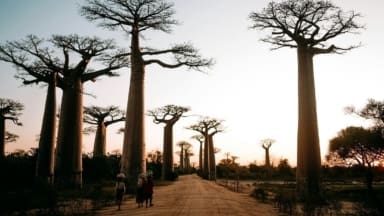
Probably the earliest record of the iconic baobab can be traced back to the Ancient Egyptians, around 2,300 BC. With their vast, enormous size, reputed longevity and diverse uses, baobabs are one of the most charismatic species on our planet. The Baobab (genus Adansonia), sometimes referred to as the upside-down tree, or the tree of life, can store large amounts of water in their trunks to survive long dry seasons. They produce large white flowers, which dangle from the branches on long stems, revealing big crinkled petals and cluster of stamen. The fruits are edible, reportedly considered a super food.
New compelling research, conducted in collaboration, by the Wuhan Botanical Garden (China), Royal Botanic Gardens (Kew, UK), University of Antananarivo (Madagascar) and Queen Mary University of London (UK) revealed not only the Baobab’s remarkable species radiation in Madagascar followed by long distance dispersal to Africa and Australia, but also, their cunning evolutionary adaptations of their pollination mechanisms which range from attracting hawkmoths, to lemurs, and even bats.
The work also sheds light on how climate change has shaped the baobab’s distribution and diversification over millions of years, offering valuable insights for understanding plant responses to future environmental shifts.
The research team first assembled the genomes of the eight recognised species and worked out their patterns of speciation. Subsequently, they analysed the genomes themselves and discovered that the ancestor of all eight species most likely radiated in Madagascar, where they made hybrids, before two species underwent astonishing long-distance travels, one to Africa and another to Australia. In that radiation the species evolved different flower structures to attract hawkmoths, lemurs and bats.
Professor Andrew Leitch at Queen Mary University of London said, “We were delighted to be involved in this project uncovering patterns of baobab speciation in Madagascar followed by the astonishing long-distance dispersal of two species, one to Africa and another to Australia. This was accompanied by the evolution of some fascinating pollination syndromes involving hawkmoths, lemurs and bats.”
Dr. Ilia Leitch at Royal Botanic Garden Kew said, “This work has uncovered new insights into the patterns of speciation in baobabs and shows how climate change has influenced baobab distribution and speciation patterns over millions of years.”
Andrew and Ilia Leitch at Queen Mary University of London and Royal Botanic Gardens Kew said, “We were delighted to be involved in this project uncovering patterns of baobab speciation in Madagascar before the astonishing long-distance dispersal of two species, one to Africa and another to Australia. The work also provides new insights into how climate change has influenced baobab distribution and speciation patterns over millions of years.”
The Adansonia (family Malvaceae) comprises of eight morphologically distinct species; Adansonia digitata which is widespread across continental Africa; Adansonia gregorii which is restricted to Northwestern Australia, and six species endemic to Madagascar – three of which are threatened with extinction (Adansonia perrieri, Adansonia grandidieri and Adansonia suarezensis). According to DNA studies, Baobabs first arose in Madagascar 21 million years ago.

